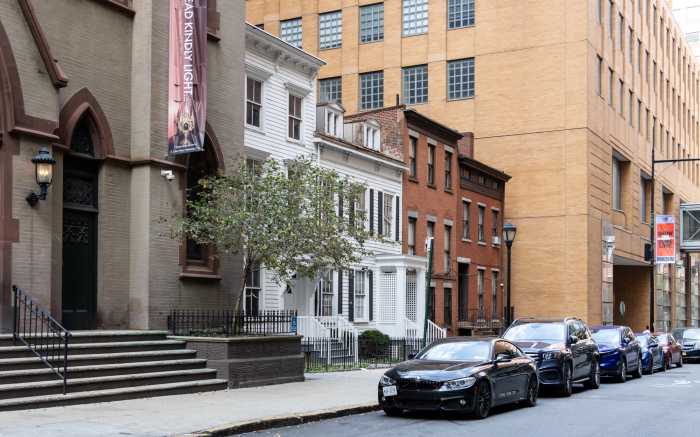Messy memoirs of an era that is mostly over
The brainchild of photographer and gallerist Clayton Patterson, known for his archive of downtown memorabilia, “Captured” was compiled with two co-editors and an army of elves. Proceeding by rheumy anecdote rather than coherent historical method, the book cobbles a series of distinct cinematic movements into a ragtag chronology. The Beats serve as creation myth, quickly eclipsed by underground cinema’s golden age of the 1960s, when such titans as Jack Smith and Andy Warhol bestrode the earth, or at least Second Avenue. Lingering over the post-punks—No Wave, the Cinema of Transgression—“Captured” ambles through the ‘80s and nearly reaches the present, with the Robert Beck Memorial Cinema. Along the way, a topography is traced of institutions gone—the Charles Theater, Films Charas, the RAPP Art Center—and those still here.
Some fine individual pieces are included, such as Matthew Yokobosky’s superb account of the pivotal No Wave group, an edifying narrative by cultural activist Alan Moore, a generous interview with Jim Jarmusch, and a moving tribute to the recently deceased indie film supplier Rafic Azzouni.
The wan attempt at a DIY aesthetic that informs the book’s design, however, fails to excuse the slipshod editing. Apart from innumerable copy errors uncharacteristic of the publisher, there are bizarre factual flubs—one entry refers to “the late Ela Troyano,” when, as of this writing, the director was busily promoting a new documentary. The book’s value is further limited by its lack of filmographies, distribution sources, or even contributors’ bios, and it comes illustrated not with stills from the scores of films and videos cited, but rather murky snapshots of its various personalities. Awkwardly oversized and sheathed in a phlegmatic black cover, “Captured” has the sensual appeal of a tombstone.
A decoder ring might help unscramble the mess. For one thing, underground cinema is merely the sacrament enshrined in “Captured”—the true religion here is bohemianism, the germinal spirit of the Beats drifting down the years. But the book also mystifies how this religion is actually practiced within the church of Manhattan real estate development.
Recall for a moment how the neighborhood became the place it is today. In the 1960s and ‘70s, the Lower East Side was one of many areas of New York wholly transformed by the national trend of deindustrialization that eliminated over half the manufacturing jobs that employed the city’s working class. This decline was intensified by deliberate, racist policies of structural disinvestment, redlining, and “planned shrinkage” that made the Lower East Side a badlands of rubble-choked lots and decaying buildings awash in drug violence.
Within just five years, between 1974 and 1979, two-thirds of the neighborhood’s total population evacuated. Thus the underdevelopment of the Lower East Side’s poor communities of color created the material conditions for the rush of speculative investment at the dawn of the Reagan era that, in turn, watered the blossoming of the early-80s East Village scene now commemorated in museum exhibitions and volumes like “Captured.”
Comprehending this is necessary not only because “Captured” is so bereft of historical structure, but also to remain alert to the various histories unrepresented here. Queers, for instance, will find this incongruously straight turf, notwithstanding co-editor Paul Bartlett’s telling comment, “The strait jacket is in the closet.” Jack Smith is duly honored and Factory associates Taylor Mead and Michel Auder make strong impressions, while the 1980s and ‘90s are skimmed in entries on Naked Eye Cinema and an interview with MM Serra, director of the Filmmakers’ Co-op.
Yet seminal East Village queer artists like Abigail Child, Tom Chomont, and Su Friedrich rate barely a mention, while Shu Lea Cheang, Cecilia Dougherty, and Tom Kalin never pierce the radar. More egregious is the blanket exclusion of the guerrilla video collectives like DIVA TV and ReproVision that enlivened the scene during the late-80s activist queeruption.
“Captured” also needs to be read in the context of FEVA, the Federation of East Village Artists, the umbrella organization formed by impresario Phil Hartman. Longtime denizens Hartman and wife Doris Kornish opened the Two Boots pizza chain in 1987, which today encompasses six Manhattan eateries, a video rental outlet, and the Pioneer Theater. The Hartmans have bona fides in the film community—Kornish ran the warmly remembered Films Charas, and Hartman directed the indie feature “No Picnic”—although to date they have resisted hiring union projectionists for the Pioneer.
Diversifying with a just-opened brasserie on Avenue A and a new entertainment complex slated for Bridgeport, Connecticut, the Hartmans’ thriving business underwrites their nonprofit endeavors such as FEVA. Billed as an independent project, Patterson explains right up front how “Captured” got started when Hartman “told me to go ahead,” and the finished product was launched at last month’s Howl Festival, FEVA’s three-year-old flagship event in Tompkins Square.
The interests behind “Captured” are more subtly legible in the acronym with which co-editor Paul Bartlett signs the editors’ introduction, AASC, which stands for the Arts Advisors to the Select Committee. This 30-member panel, operating under the City Council Select Committee on Lower Manhattan Redevelopment, was convened as a municipal counterbalance to Governor George Pataki’s Lower Manhattan Development Corporation. Arguing the merits of culture as a lubricant of economic renewal, the AASC hopes to influence the LMDC’s allocation of the final post-9/11Community Development Block Grants to benefit struggling arts groups increasingly priced out of areas like the East Village. Read in this light, “Captured” functions as an investment prospectus for the Lower East Side “cultural campus,” in the words of a plan propounded by Select Committee chairman Alan Gerson, who represents Lower Manhattan in the Council.
Among the vanished repertory houses where I got much of my early film education, the Theater 80 at St. Marks and First Avenue was never my favorite—the funky rear-projection system and kneecap-crushing seats precluded such allegiance. But its grotto atmosphere and rotating calendar bewitched me, as if these particular films, played in just the right sequence, might disclose some fabulous secret. One year I braved the New Year’s Eve champagne toast. Cheap bubbly was sloshed into plastic cups and the small group of film-besotted strangers stood around the checker-tiled lobby, smiling furtively at one another, waiting for the countdown.
Reading “Captured” inspires one more toast to the old neighborhood. It was great while it lasted—may it rest in peace.
gaycitynews.com




































